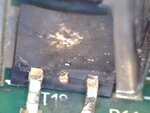T
treez
Guest
It always has whenever ive done this accidetally, but is it always the case?
(we are designing a simple cct to blow a fuse whenever vin goes above 400V, and this is the principle involved.......or one of them....we tryed other ways but short 50us excursions above 400v couldnt be detected......the boss doesnt want much if any circuitry involved either)
The attached is our schem of our overvoltage detector
We wonder if the "bjt detector" might be better than the fet based one...better at blowing the fuse so as to detect any >400v events?
(we are designing a simple cct to blow a fuse whenever vin goes above 400V, and this is the principle involved.......or one of them....we tryed other ways but short 50us excursions above 400v couldnt be detected......the boss doesnt want much if any circuitry involved either)
The attached is our schem of our overvoltage detector
We wonder if the "bjt detector" might be better than the fet based one...better at blowing the fuse so as to detect any >400v events?
Attachments
Last edited by a moderator:



